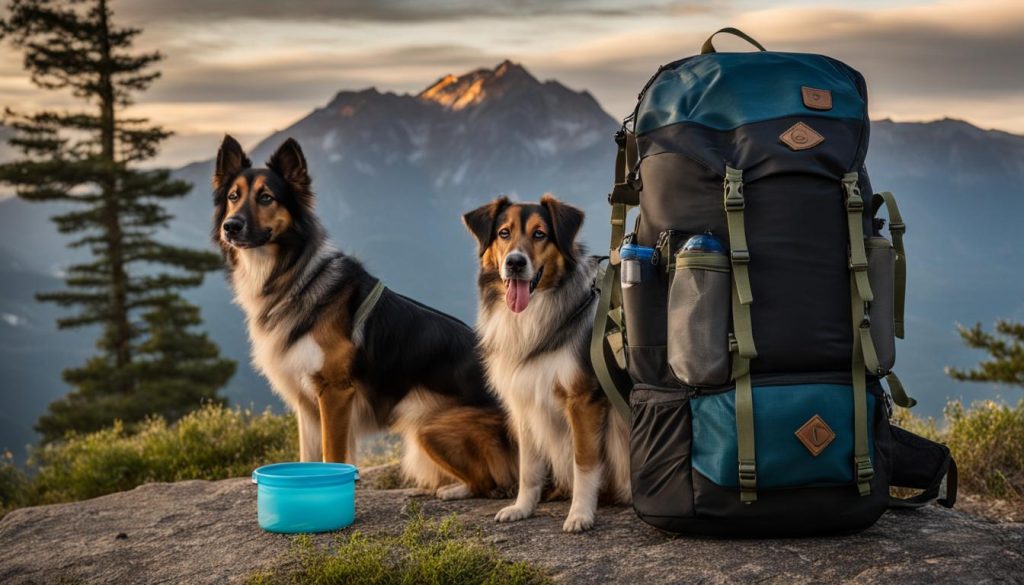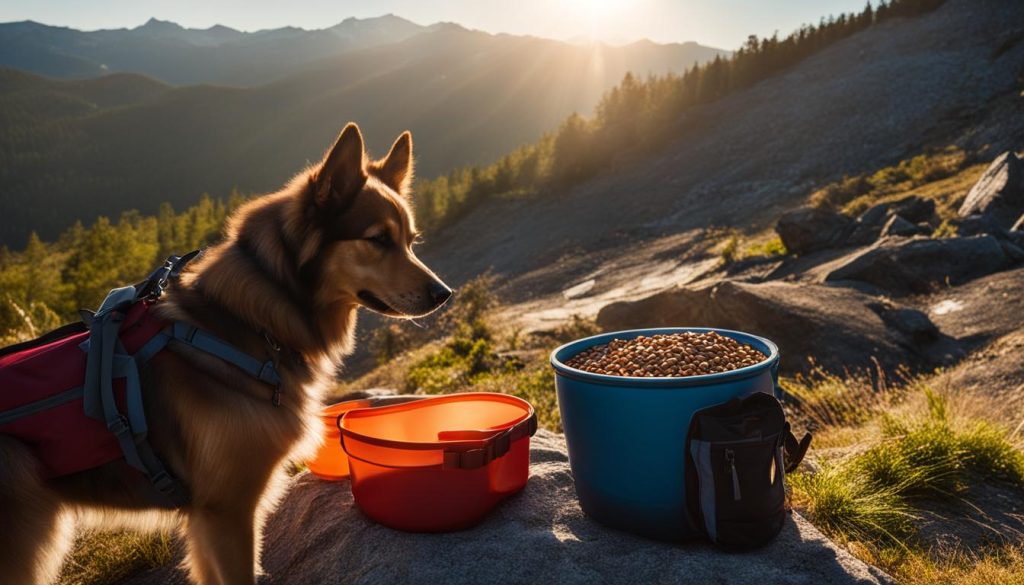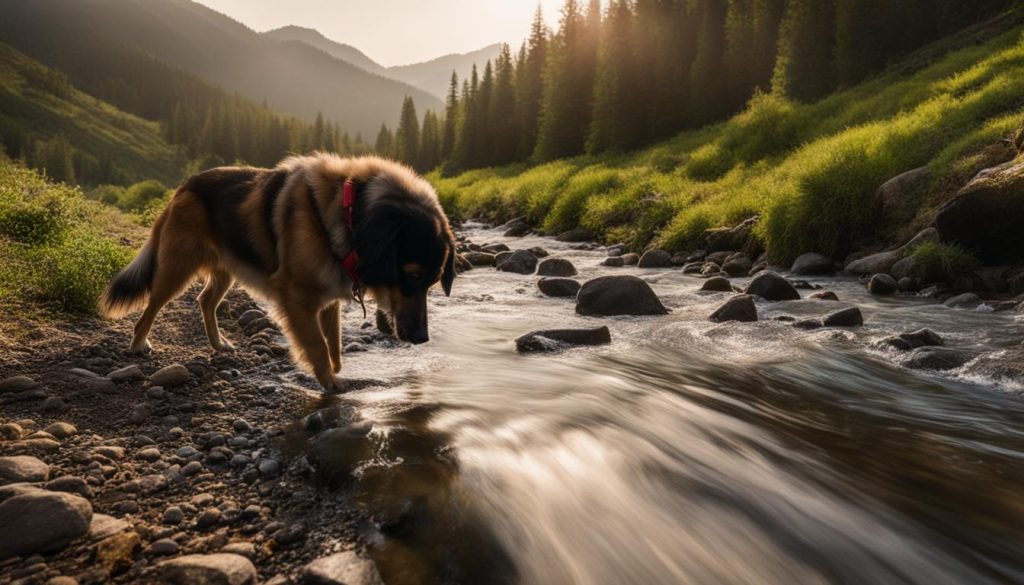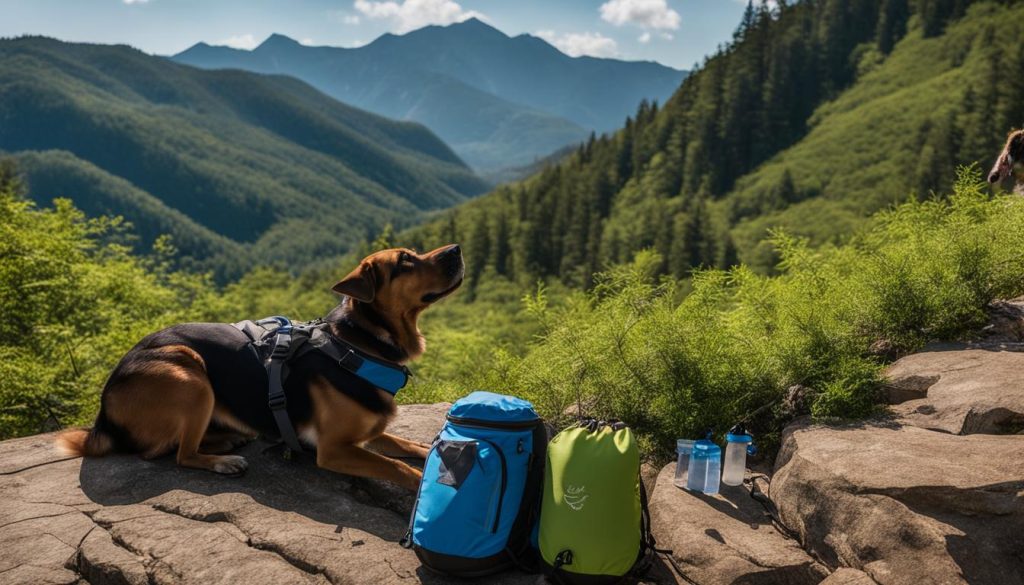When hiking with your dog, it is essential to prioritize their hydration to ensure their safety and well-being on the trails. By following these expert tips, you can keep your furry friend hydrated and healthy while enjoying your outdoor adventures together.
Key Takeaways:
- Bring enough water for your dog and offer regular water breaks.
- Consider investing in a dog pack to evenly distribute weight and allow your dog to carry their supplies.
- Pack essential gear such as a water container, booties for paw protection, and a first-aid kit.
- Plan ahead for your dog’s food and water needs, especially on longer hikes.
- Be aware of potential trail hazards and take necessary precautions to keep your dog safe.
Preparing Your Pup for the Trail
Before embarking on a hiking adventure with your dog, please ensure that they are physically prepared and well-trained. First and foremost, consult with your veterinarian to assess your pup’s fitness level and discuss any necessary vaccinations or preventative medications. A thorough physical examination will help determine if your dog is ready for the rigors of hiking. Additionally, consider your dog’s breed and age as factors that may influence their ability to handle strenuous activities.

Once you’ve received the green light from your vet, it’s time to focus on training. Obedience training is essential to ensure that your dog follows commands and behaves appropriately on the trail. Start with basic commands like “sit,” “stay,” and “come” to establish control and prevent any potential safety issues. You should also train your dog to walk comfortably on a leash and practice proper trail etiquette, such as yielding to other hikers.
Another crucial aspect of preparing your pup for the trail is socialization. Expose your dog to various environments, wildlife, and other dogs. This will help reduce anxiety and aggression, making your hiking experience more enjoyable and safe. Engage in positive reinforcement training methods to reward desired behaviors and reinforce good manners.
Training Checklist for Hiking with Dogs
- Consult with your veterinarian to assess your dog’s physical readiness
- Train your dog in basic obedience commands
- Practice leash manners and trail etiquette
- Socialize your dog with other dogs and different environments
- Use positive reinforcement techniques to reinforce good behavior
By properly preparing your pup for the trail through physical fitness, obedience training, and socialization, you’ll ensure a safer and more enjoyable hiking experience for both you and your furry companion.
The All-Important Dog Pack
When preparing for a hike with your furry companion, don’t forget to equip them with a dog pack. A dog pack is an essential gear item that allows your dog to carry their own supplies, while also providing them with a sense of purpose and responsibility on the trail. Not only does it lighten your load, but it also helps distribute the weight evenly, ensuring your dog’s comfort during your outdoor adventures.
Choosing the right dog pack involves finding the perfect fit for your dog. Measure their chest circumference and select a pack that matches their size. I recommend that you adjust the straps to make sure the pack fits snugly and doesn’t restrict their movements. Gradually increase the weight your dog carries in the pack during training hikes to build up their strength and endurance.
A well-equipped dog pack should include essentials such as water, food, and waste bags. Additionally, consider packing a collapsible bowl for easy access to water on the trail. Your dog’s pack can also carry other items that may be useful, such as a towel or a small first-aid kit. Just remember not to overload the pack and ensure your dog can comfortably carry the weight.

Essentials to Pack in a Dog Pack:
- Water bottles or collapsible water bowl
- High-quality dog food or treats
- Waste bags for responsible waste management
- Small first-aid kit for emergencies
- Extra leash and collar with identification tags
- Collapsible bowl for easy access to water
- Lightweight towel for drying off
With a well-fitted dog pack and the right essentials, your furry friend will be well-prepared for any hiking adventure. Just remember to monitor their behavior and ensure the weight they’re carrying is comfortable for them. Happy trails!
Other Gear Considerations
When it comes to hiking with your dog, the right gear can make all the difference in ensuring their comfort and safety on the trails. In addition to a dog pack, there are several other essential gear items that you should consider including in your hiking checklist.
Gear Checklist:
- A roomier tent: Investing in a tent that can accommodate both you and your dog will provide extra space and comfort during overnight trips. Make sure to choose a tent with proper ventilation and durability.
- A specialized first-aid kit: Just like humans, dogs can get minor injuries on the trail. Having a first-aid kit specifically designed for dogs will allow you to quickly address any cuts, scrapes, or insect bites.
- A water container: Carrying sufficient water for your dog is crucial, but having a dedicated water container for them makes it easier to offer frequent hydration breaks. Look for collapsible options that are lightweight and portable.
- Booties for paw protection: Dog booties can help protect your dog’s paws from rough terrain, hot pavement, or sharp objects. Choose booties that are durable, comfortable, and provide proper traction.
By including these gear items in your hiking arsenal, you can ensure that your dog is well-prepared for the challenges of the trail. Try to gradually introduce new gear to your dog during training hikes to familiarize them with the items and ensure they are comfortable wearing or using them.

| Item | Description |
|---|---|
| A roomier tent | An investment in a tent that can accommodate both you and your dog will provide extra space and comfort during overnight trips. Choose a tent with proper ventilation and durability. |
| A specialized first-aid kit | Having a first-aid kit specifically designed for dogs will allow you to quickly address any cuts, scrapes, or insect bites that your dog may encounter on the trail. |
| A water container | A dedicated water container for your dog makes it easier to offer frequent hydration breaks. Look for collapsible options that are lightweight and portable. |
| Booties for paw protection | Dog booties can help protect your dog’s paws from rough terrain, hot pavement, or sharp objects. Choose booties that are durable, comfortable, and provide proper traction. |
By including these gear items in your backpack, you can provide your dog with the necessary comfort and protection while enjoying your outdoor adventures together.
Food and Water Planning
Planning ahead for your dog’s food and water needs while hiking is crucial to ensure their well-being on the trail. Dogs require more fuel and hydration during backpacking trips, so pack enough food and carry fresh water for your furry companion. Monitoring your dog’s water intake and providing regular water breaks, especially on hot days, is essential to prevent dehydration. Look out for signs of dehydration such as excessive panting and a dry nose, and address them immediately. Prioritizing your dog’s hydration will help them stay energized and healthy throughout your hike.
When it comes to food, pack enough nutritious meals for your dog to maintain their energy levels on the trail. Consider lightweight, compact, and high-quality dog food that is specifically formulated for outdoor activities. Opt for portioned meals or food that can be easily rehydrated with water, making it convenient for you to feed your dog while on the go. Try to pack food in airtight containers to keep it fresh and prevent it from attracting unwanted wildlife. Additionally, bring along collapsible food and water bowls for your dog’s convenience.
Proper meal and water planning ensures that your dog stays energized, well-nourished, and hydrated during your hiking adventure. By taking these simple yet important steps, you can provide your dog with the necessary sustenance they need to thrive on the trail.

| Food and Water Planning | Tips |
|---|---|
| Pack enough food | Bring sufficient, lightweight, and nutritious dog food for your pet |
| Carry fresh water | Ensure you have an ample supply of clean, fresh water for your dog |
| Monitor water intake | Regularly offer water breaks and keep an eye out for signs of dehydration |
| Pack airtight containers | Store dog food in sealed containers to maintain freshness and prevent attracting wildlife |
| Use compact bowls | Bring collapsible food and water bowls for easy storage and feeding |
By properly planning and packing food and water for your dog, you can ensure their health and hydration on the trail. To put it simply, a well-fed and hydrated dog is a happy and energetic hiking companion!
Trail Hazards for Dogs: Hiking with Dogs Safety Tips
When embarking on a hiking adventure with your canine companion, it is good practice to be aware of potential trail hazards to ensure the safety and well-being of your furry friend. By taking the necessary precautions and following these hiking with dogs safety tips, you can minimize risks and enjoy your outdoor experience to the fullest.
Water Safety Concerns
Dogs, just like humans, can be at risk when it comes to water safety on the trails. Avoid allowing your dog to drink from unknown water sources, as they may be contaminated and cause gastrointestinal issues. Additionally, keep a close eye on your dog near bodies of water, especially fast-moving rivers or deep lakes. Consider investing in a dog life jacket if you plan on crossing bodies of water or spending time near them.
Heat-related Risks
Hot weather conditions can pose significant risks to dogs while hiking. Keep an eye out for signs of overheating, such as excessive panting, drooling, or lethargy. Provide regular breaks in shaded areas and offer fresh water for your dog to drink. Opt for hiking during cooler parts of the day, such as early mornings or late evenings, and avoid hiking on extremely hot days.
Encounters with Wildlife
Wildlife encounters can be exciting, but they can also be dangerous for both your dog and the wildlife itself. Keep your dog on a leash at all times and avoid allowing them to approach or chase after wild animals. This not only protects your pet from potential harm but also helps preserve the natural habitat and behavior of wildlife. Stay alert and be aware of your surroundings to prevent any unwanted encounters.
By being mindful of these trail hazards and implementing proper safety measures, you can ensure a safe and enjoyable hiking experience with your beloved four-legged companion.

Planning Dog-Friendly Hiking Trips
When it comes to planning a hiking trip with your dog, choose dog-friendly hiking locations that offer suitable trails and amenities. Doing your research ahead of time will ensure a safe and enjoyable experience for both you and your furry friend. Here are some tips to help you plan accordingly:
1. Research Dog-Friendly Trails
Look for hiking trails that explicitly allow dogs. Many national parks and state parks have specific areas designated for canine companions. Check online resources or guidebooks that provide information about dog-friendly trails in your area. Look for details such as trail length, difficulty level, and any specific rules or regulations for dogs. It’s also worth considering the trail terrain and if it is suitable for your dog’s fitness level.
2. Consider Amenities
Take into account the amenities available at the hiking location. Are there dog-friendly campgrounds or accommodations nearby? Are there pet waste stations or garbage bins along the trail? I recommend that you choose a location that provides the necessary facilities to ensure your dog’s comfort and sanitation needs are met. Additionally, check if there are any restrictions on leash length or if there are designated off-leash areas where your furry friend can have some freedom to roam.
3. Check for Permits and Reservations
Some hiking areas require permits or reservations, especially for popular trails or during peak seasons. Make sure to check if there are any permit or reservation requirements for the dog-friendly hiking location you are considering. This will help you avoid any surprises or disappointments on the day of your hike.
4. Familiarize Yourself with Trail Rules
Before heading out on your hike, familiarize yourself with the trail rules and regulations. This includes leash requirements, trail closures, and any restrictions on dog access to certain areas. By following the trail rules, you not only ensure the safety of your dog but also help maintain the natural environment and the enjoyment of other hikers.
By taking these factors into consideration and carefully planning your dog-friendly hiking trip, you can ensure a memorable and enjoyable outdoor adventure for both you and your furry companion.
Essential Gear for Hiking with Dogs
When it comes to hiking with your furry friend, having the right gear is essential for their comfort and safety. Here is a checklist of gear items that you should consider packing for your dog:
- Sturdy leash, harness, and collar with identification tags: These will keep your dog secure and easily identifiable while on the trail.
- Food, water, and bowls: Pack enough food to sustain your dog throughout the hike and carry fresh water to keep them hydrated. Collapsible bowls are convenient for feeding and watering breaks.
- Dog bed or sleeping pad: Providing a comfortable resting spot for your dog at camp will ensure they get a good night’s sleep after a day of hiking.
- First-aid kit: Be prepared for any minor injuries or ailments by carrying a first-aid kit specifically designed for dogs. Include items like bandages, antiseptic wipes, and tweezers for tick removal.
- Protective booties: These can protect your dog’s paws from rough terrain, hot surfaces, thorns, and other hazards they may encounter on the trail.
In addition to these essentials, consider the specific needs of your dog and the environment you will be hiking in. For example, if you are hiking in colder weather, a doggy jacket or sweater may be necessary to keep your dog warm. Similarly, if you are hiking in an area with a high tick population, additional tick prevention measures may be required. By packing the right gear, you can ensure a successful and enjoyable hiking experience for both you and your canine companion.

Tips for Choosing the Right Gear
When selecting gear for your dog, consider their size, breed, and individual needs. Here are a few tips to help you choose the right gear:
- Ensure proper fit: Leashes, harnesses, and packs should be sized to fit your dog comfortably and securely. Measure your dog’s chest circumference and consult the manufacturer’s sizing guide to find the right fit.
- Choose durable materials: Opt for gear made from high-quality and durable materials that can withstand the rigors of the trail. Look for reinforced stitching and strong hardware.
- Consider weight distribution: If using a dog pack, make sure it has adjustable straps and a design that evenly distributes weight across your dog’s body. Gradually increase the weight your dog carries during training hikes to build their strength.
- Prioritize safety: Look for gear that includes reflective elements for increased visibility, especially if hiking in low-light conditions. Ensure that collars, harnesses, and leashes have secure closures to prevent accidental escapes.
By investing in the right gear and taking the time to choose items that fit well and meet your dog’s specific needs, you can set them up for a successful hiking adventure.
Dog Training for Hiking
Proper training and socialization are crucial when it comes to hiking with your dog. By investing time and effort into training, you can ensure that your furry companion is well-behaved and able to handle the challenges of the trail.
One important aspect of training is teaching your dog basic commands such as “sit,” “stay,” and “come.” These commands will not only make your hiking experience more enjoyable but also ensure your dog’s safety. In addition to obedience training, I would advise that you train your dog to walk on a leash without pulling. This will help you maintain control and prevent your dog from wandering off or getting into potentially dangerous situations.
Socialization is another vital aspect of dog training for hiking. Exposing your dog to different environments, people, and other animals will help reduce anxiety and aggression on the trail. Take your dog to dog parks or arrange playdates with other friendly dogs. This will help them learn how to interact appropriately and peacefully with other animals.
To put it simply, training is an ongoing process, and consistency is key. Keep practicing commands and reinforcing good behavior both on and off the trail. With time and patience, your dog will become a well-trained hiking companion.
Benefits of Training and Socialization
- Improved obedience and control on the trail
- Enhanced safety for both your dog and others
- Reduced anxiety and aggression
- Increased enjoyment of the hiking experience
“Proper training and socialization are crucial for a successful hiking experience with your dog.”
Quotes:
“Training and socializing your dog not only makes them a better hiking companion but also enhances their overall behavior and well-being.”
“By investing time and effort into training, you can ensure that your dog is well-behaved, obedient, and able to handle the challenges of the trail.”
By focusing on training and socialization, you can have a positive and enjoyable hiking experience with your dog. The time and effort invested in training will pay off in the form of a well-behaved and well-adjusted hiking companion. So, start early, be consistent, and enjoy the adventures with your furry friend!
Follow Trail Etiquette
When hiking with your furry companion, I would advise that you adhere to trail etiquette to ensure a responsible and enjoyable experience for everyone. By following these guidelines, you can minimize your impact on the environment, respect other hikers, and prioritize the safety of your dog.
Keep Your Dog on a Leash
One of the most important rules of trail etiquette is to keep your dog on a leash unless you are in a designated off-leash area. This not only prevents your dog from disturbing wildlife but also ensures that they don’t approach other hikers who may have fears or allergies. Always use a sturdy leash and keep it at a length that allows you to maintain control of your dog.
Yield to Other Hikers
When encountering other hikers on the trail, yield to them and give them the right of way. Step aside and allow them to pass, especially if they are carrying heavy loads or have dogs that are reactive or anxious. Be polite and friendly, and remember that not everyone may be comfortable around dogs, so I would advise that you respect their space.
Prevent Your Dog from Disturbing Wildlife
While hiking, please prevent your dog from disturbing wildlife. Keep them on the designated trails and discourage them from chasing or approaching wildlife. This helps to protect both the wildlife and your dog from potential harm. Also, be aware of any trail closures or restricted areas that may be in place to protect sensitive habitats or nesting sites.
By following these trail etiquette guidelines, you can ensure a positive experience for yourself, your dog, and fellow hikers. Respect the rules and regulations of the trail, be considerate of others, and enjoy the beauty of nature responsibly.
Final Thoughts
To sum it up, keeping your dog hydrated while hiking is of utmost importance to ensure their well-being on the trail. By following these expert tips, you can ensure that your furry friend stays healthy and safe during your outdoor adventures together.
Firstly, remember to plan ahead and pack enough food and water for your dog. Dogs require more fuel and hydration during hiking trips, so make sure to monitor their water intake and offer regular water breaks. Be attentive to signs of dehydration and address them immediately.
Secondly, equip yourself with the right gear to support your dog’s hydration needs. Consider investing in a dog pack, which allows your furry companion to carry their own supplies and distribute the weight evenly. Additionally, pack a water container and booties to protect your dog’s paws.
Lastly, prioritize training and socialization for your dog. Proper obedience training and socialization will ensure that your dog behaves appropriately on the trail, reducing the risk of accidents and conflicts with other hikers or wildlife.
By following these expert tips for keeping your dog hydrated on the trail, you can have a safe and enjoyable hiking experience with your canine companion. Try to plan accordingly, pack the right gear, train and socialize your dog, and always prioritize their hydration needs. Happy hiking!
FAQ
How can I ensure my dog stays hydrated while hiking?
Prioritize your dog’s hydration by carrying enough fresh water for them and offering regular water breaks. Monitor their water intake and watch out for signs of dehydration, such as excessive panting and a dry nose.
How should I prepare my dog for hiking?
Consult with your vet to determine if your dog is physically fit for hiking and ensure they have the necessary vaccinations. Brush up on obedience training and trail etiquette, and gradually build up your dog’s strength through training hikes.
Is a dog pack necessary for hiking with my dog?
Yes, a dog pack is essential for hiking with your furry companion. It allows them to carry their own supplies and distributes the weight evenly. Make sure to measure your dog’s chest circumference to find the right size pack and adjust the straps for a snug fit.
What other gear should I consider for hiking with my dog?
In addition to a dog pack, consider investing in a roomier tent to accommodate your dog, a specialized first-aid kit for any potential injuries, a water container, and protective booties for their paws.
How should I plan for my dog’s food and water needs while hiking?
Dogs require more fuel and hydration during hiking trips, so pack enough food and carry fresh water for your pet. Monitor their water intake and offer regular water breaks, especially on hot days. Watch out for signs of dehydration and address them immediately.
What trail hazards should I be aware of when hiking with my dog?
Trail hazards may include water safety concerns, heat-related risks, encounters with wildlife, ticks, and toxic plants. Learn to recognize signs of overexertion in your dog and take precautions to prevent tick bites and avoid toxic plants.
How do I plan a dog-friendly hiking trip?
Research and choose dog-friendly hiking locations that offer suitable trails and amenities. Check if permits or reservations are required, consider the terrain and difficulty level, and familiarize yourself with trail rules and regulations.
What gear should I pack for my dog for hiking?
Pack a sturdy leash, harness, and collar with identification tags for security. Also, bring enough food, water, and bowls for your dog’s meals and hydration. Additional gear may include a dog bed or sleeping pad, first-aid kit, and protective booties.
Is training and socialization important for hiking with my dog?
Yes, proper training and socialization are crucial for a successful hiking experience. Ensure your dog is well-trained in basic commands and practices good leash manners. Socialize them with other dogs, wildlife, and different environments to reduce anxiety and aggression.
How should I follow trail etiquette while hiking with my dog?
Familiarize yourself with trail rules and regulations, keep your dog on a leash unless in designated off-leash areas, yield to other hikers, prevent your dog from disturbing wildlife or other hikers, and maintain control at all times.
What are the key tips for keeping dogs hydrated while hiking?
Prioritize your dog’s hydration, prepare them physically, invest in essential gear, plan for food and water, be aware of trail hazards, choose dog-friendly locations, pack the right gear, train and socialize your dog, and follow trail etiquette.






